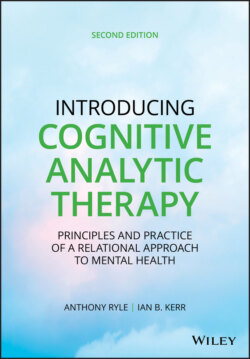Читать книгу Introducing Cognitive Analytic Therapy - Anthony Ryle - Страница 15
Оглавление
The Structure of the Book
Chapters 1 and 2 will give a brief account of the scope and focus of CAT and how it evolved and will spell out the main features of its practice. Most of CAT's relatively few technical terms will appear in these chapters; they and other general terms which may have a different meaning in CAT are listed in a glossary. In order to flesh out this introductory survey and give readers a sense of the unfolding structure of a time‐limited CAT, Chapter 2 also offers a brief account of a relatively straightforward therapy. Chapters 3 and 4 consider the normal and abnormal development of the self and introduce the Vygotskian and Bakhtinian concepts which are part of the basic theory of individual development and change. Subsequent chapters describe selection and assessment (Chapter 5); reformulation (Chapter 6); the course of therapy (Chapter 7); the “ideal model” of therapist interventions and its relation to the supervision of therapists (Chapter 8); applications of CAT in various patient groups and settings (Chapter 9) and in treating personality‐type disorders (Chapter 10); and the concept of the “difficult” patient and approaches to this problem, including the use of “contextual reformulation” and use in “reflective practice” (Chapter 11). Each chapter commences with a brief summary of its contents and includes suggestions for further reading and references to CAT published work, and to the work of others. In addition, Appendix 1 contains the CAT Psychotherapy File, Appendix 2 the summary of CAT competences extracted from Roth and Pilling (2013), Appendix 3 contains the Personality Structure Questionnaire, and Appendix 4 a description of repertory grid basics and their use in CAT.
Case material derived from audio‐taped sessions is used with the permission of both patients and therapists; we gratefully acknowledge their help. Other illustrative material is either drawn from composite sources or disguised in ways preventing recognition. We have, on the whole, referred to patients rather than clients, although in this book we use the term interchangeably.
Further Information
Further information about CAT and about the Association for Cognitive Analytic Therapy (ACAT) in the UK may be obtained from the website www.acat.me.uk in the UK, from local associations in other countries, and/or through www.internationalcat.org.
